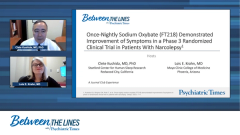
Key Takeaways and Management of Narcolepsy
Takeaways of the REST-ON clinical trial results as presented in Sleep that help clinicians learn more about the management of patients with narcolepsy.
Episodes in this series
Clete Kushida, MD, PhD: So, the study that will be discussed is that once-nightly sodium oxybate, or FT218, demonstrated improvement of symptoms in a phase 3 randomized clinical trial in patients with narcolepsy. And it is my great pleasure to introduce Dr Lois Krahn at the Mayo Clinic College of Medicine in Phoenix, Arizona.
Lois E. Krahn, MD: Well, thank you, Dr Kushida. Very nice to be here with you.I was going to say that the data from this paper is incredibly valuable to those of us who treat patients with narcolepsy. I mean, it shows that patients are better able to stay awake, as measured by the Maintenance of Wakefulness Test (MWT) and by the Epworth Sleepiness Score. It also shows that cataplexy is controlled on once a night sodium oxybate as compared to placebo. And lastly, that the patient’s quality of life improves. So, on all 3 of those important measures, this medication appears to be effective. That’s very useful to the medical community and to our patients. Thank you.Dr Kushida, how does this paper contribute to our understanding of the use of once-nightly sodium oxybate for the improvement of symptoms in patients with narcolepsy?
Clete Kushida, MD, PhD: These type of modified release formulations are commonly applied to different therapies, mainly to decrease patient burden since they can improve the adherence with a regimen and, ultimately, enhance the overall patient experience. For chronic medical conditions, such as narcolepsy, this is very important because, as we all know, narcolepsy is significantly debilitating to almost every aspect of a patient’s life when it is not successfully treated. Now, the once-nightly sodium oxybate has received orphan drug designation from the U.S. Food and Drug Administration based on its plausible hypothesis that it may be clinically superior to the twice-nightly formulation of sodium oxybate already approved from the same indication. And there are several discreet advantages to once-nightly dosing. First, it may result in better medication adherence for patients. It may also result in a beneficial effect on nocturnal sleep. Additionally, a once-nightly sodium oxybate will avoid the patient having a scheduled awakening and also, potentially, awaking the bed partner, since the patient would have to self-administer the second dose of twice-nightly sodium oxybate. And lastly, the plasmic concentrations decline steadily after the first and only Cmax, which occurs early in the night, post-dose, with this once-nightly sodium oxybate. So it’s possible that this formulation, compared to twice-nightly sodium oxybate, may be less likely to be associated with falls given the lower peak plasma concentration, lower concentration of 8 hours, and the once-nightly dosing. Thank you.
Lois E. Krahn, MD: I’m going to add 1 other point on that. You know, when a person is starting oxybate therapy and we explain to them that this is a medicine that’s been available now for some time, but they need to take it twice during the night, my experience is that they are surprised because they have never heard of a medication that is repeated partway through the night. And sometimes they are hesitant; for younger patients, sometimes their families are hesitant. And this formulation, now proven to be effective, clearly simplifies it, and I think will take away some of the reluctance that patients who have never used sodium oxybate have experienced previously.
Clete Kushida, MD, PhD: That’s a great point, Lois.
Transcript edited for clarity.
Newsletter
Receive trusted psychiatric news, expert analysis, and clinical insights — subscribe today to support your practice and your patients.









